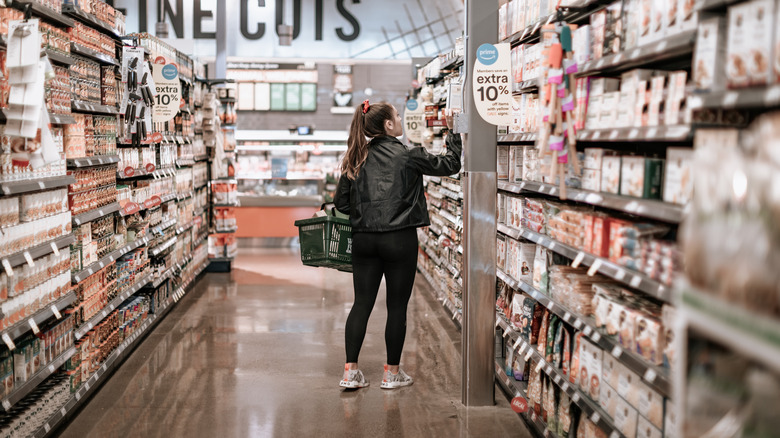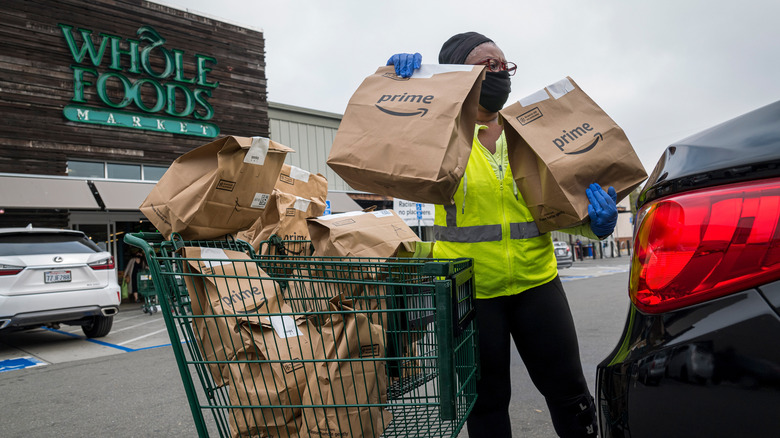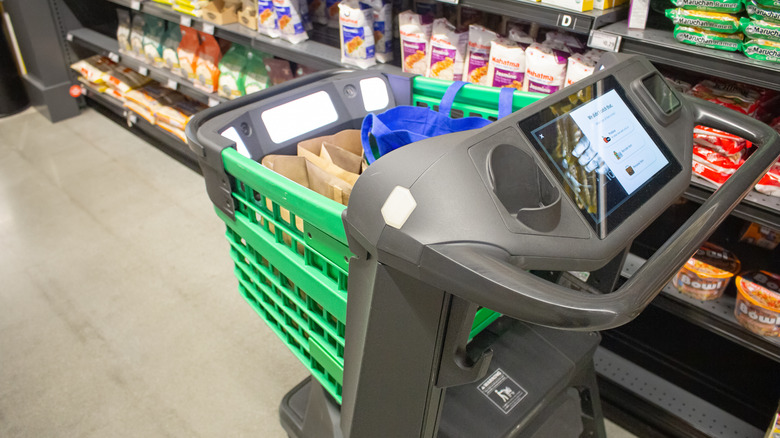Is There A Real Difference Between Amazon Fresh And Whole Foods?
We may receive a commission on purchases made from links.
Two stores operated by the same company — how different can they be? Plenty, which you'll soon discover when shopping at one of the 500-plus Whole Foods or 44 Amazon Fresh stores. Amazon entered the brick-and-mortar grocery market in 2017 after purchasing the already-established Whole Foods Market for $13.7 billion, per Business Insider. Fears of the online retailer transforming the high-end grocery store chain into something unrecognizable have mostly subsided after five years, especially as Amazon appeals to a decidedly different demographic with its growing number of Amazon Fresh stores.
Both grocery venues offer in-store shopping as well as online ordering for pickup or delivery, and U.S. shoppers can order from either store while on the Amazon website. You'll have two separate shopping carts, which generate automatically when adding an item from either store. Both offer same-day delivery in many cities, which was previously free when purchasing a specified dollar amount. But Whole Foods made the bold move of adding a delivery fee of $9.95 as of October 2021, regardless of whether the customer buys one item or 100, per INC.
Delivery fees are only one of the increasingly obvious distinctions between the two Amazon grocery outlets. Believe it or not, some people seem unbothered by the tacked-on delivery fee — but they do care about, and welcome, quite a few of the new Amazon Fresh features.
Whole paycheck
Amazon Fresh is a relatively new upstart within the Amazon network of physical stores, opening to the general public in September 2020 in Woodland Hills, California, according to Supermarket News. Buzzy features such as the Alexa-powered digital shopping attendant piqued the interest of digital-first consumers, but other high-tech benefits quickly took the spotlight when compared to Amazon's "older sisters," the Whole Foods Market stores. Prices, technology, and locations for Amazon Fresh stood in stark contrast to the hundreds of Whole Foods venues, which is something that remains true as Fresh evolves after roughly two years.
The tongue-in-cheek moniker of "Whole Paycheck" says it all really, when it comes to prices. Whole Foods is known for above-average grocery prices tailored to specific types of shoppers. As CNN points out, the stores focus on natural, organic foods and products, appealing to customers with higher discretionary spending habits and the means to invest their food dollars in specialized brands. As a well-established business prior to joining the Amazon family, the built-customer base was unlikely to change much.
Winsight Grocery Business (WGB) describes a data assessment of Whole Foods shoppers using designations such as "healthy and wealthy" and "mature and assured." By contrast, the report describes Amazon Fresh as a mid-market option with more diverse, frugal customers. That doesn't mean it's a down-market chain; in fact, the technology-driven focus of Fresh fuels a demographic of busy professionals and families who appreciate convenience, a wider selection of everyday items, and more affordable prices.
Just walk out
Traditional shoppers may prefer established brick-and-mortar stores like Whole Foods, without the pressure to learn new technology. But Amazon Fresh may change that mindset, especially for those living in areas where many of the initial Fresh stores opened, notes CNN. Dashing in and out of a grocery store becomes literal if you're willing to embrace the digital tools available when entering and exiting a physical Fresh location.
Though shopping at an Amazon Fresh store doesn't require an Amazon Prime account or an Amazon store or credit card, there are some advantages to joining up, including access to discounts, cash-back, or weekly in-store deals, explains Amazon. Then there are the handy new digital features known as Amazon Dash Cart and Just Walk Out. First, you log into a "smart" shopping cart with your Amazon phone app, and the shopping cart itself scans grocery items as you add them to supplied bags. It uses sensors, bar code readers, and scales for items such as fresh produce, explains CNN. Your digital assistant, Alexa, responds to any questions you have and directs you to the proper aisle.
When you're finished shopping, the "Just Walk Out" technology springs into action, enabling you to literally walk out the door without physically paying. A lane equipped with a sensor automatically charges the stored credit card in your Amazon account. However, if you'd prefer to stand in line and manually pay as you would in Whole Foods stores, you're free to do so.


